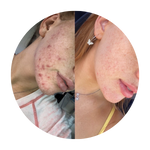His Hair is Thinning? Here’s The Science Behind Male Hair Loss
Over 60% of men will notice visible hair loss by the time they hit 35.*
For many, it’s more than just a change in appearance. Hair loss can affect a man’s confidence, how they see themselves and even everyday mood. Contrary to popular belief, hair thinning isn’t just about age, genetics or “inheriting Dad’s hairline.” It’s a complicated process that involves hormones, nutrition, circulation and lifestyle — all working together in ways that are different for every man.
Hair follicles are sensitive to small changes in the body, and over time those changes can make hair thinner, slower to grow and more fragile. Understanding what’s actually happening beneath the surface can help men feel more in control and better equipped to support their hair health.
Let’s take a close look at the key factors behind male hair thinning so you can support the men in your life to regain their hair (and their confidence!).
-
Hormones: The DHT Connection
A major player in male hair loss is dihydrotestosterone (DHT), a hormone derived from testosterone. In men genetically predisposed to hair loss, DHT binds to receptors in hair follicles and causes them to shrink, a process known as follicular miniaturisation. As follicles shrink, they produce thinner and shorter hairs until they eventually stop producing hair altogether. This hormonal sensitivity usually affects specific scalp areas (the temples and crown) leading to the classic “male pattern” hair loss. It’s important to note that not all men produce excess DHT, and not all follicles are equally sensitive. This explains why hair loss patterns and severity vary from man to man.
-
Genetics: Sensitivity to DHT and Hair Follicle Health
Your genes largely determine how sensitive your hair follicles are to DHT. Men who inherit certain genetic markers have follicles that are more vulnerable to DHT’s effects, making hair thinning more likely. This genetic predisposition influences the rate and extent of hair loss. It also means that even if your hormone levels are normal, your follicles could still shrink and thin due to inherited sensitivity. Genetic testing can sometimes help identify risk, but it’s not the only factor at play.
-
Nutrient Gaps: Supporting Hair Growth From Within
Healthy hair growth requires a steady supply of nutrients. Zinc, iodine, biotin, vitamin D, and iron are just some of the essential nutrients that support the hair growth cycle. Deficiencies can disrupt the anagen (growth) phase and weaken hair follicles, making hair more prone to shedding. For example, zinc plays a critical role in hair tissue growth and repair, while iodine is important for thyroid function — and thyroid hormones regulate metabolism, which impacts hair health. Ensuring a balanced diet, rich in plant diversity, quality protein, healthful fats and fibre (plus supplementing where needed) can help maintain strong hair and a healthy scalp.
-
Stress and Lifestyle: The Invisible Hair Thinners
Physical and emotional stress can wreak havoc on the entire body’s sense of equilibrium. Chronic stress can push hair follicles into a resting phase prematurely, leading to increased shedding known as telogen effluvium. Other lifestyle factors like sleep deprivation, overtraining and restrictive diets all disrupt the delicate hormonal balance required for optimal hair growth. The scalp is highly sensitive to these changes, which can accelerate hair thinning. Managing stress through sleep, nutrition, gentle movement and daily self-care can support healthier hair cycles.
-
Circulation: Delivering Nutrients to Hair Follicles
Blood flow is essential to deliver oxygen and nutrients to hair follicles. Poor circulation can starve follicles, reducing their ability to produce healthy hair strands. Conditions such as diabetes, smoking and sedentary lifestyles can impair scalp circulation. Regular exercise and scalp massages may help improve blood flow and support follicle health.
References:
*American Hair Loss Association, “Men’s Hair Loss Facts”.
Birch, M.P. & Messenger, A.G., 2001. Genetic factors predispose to balding and non-balding in men. European Journal of Dermatology, 11(4), pp.309–314. PMID: 11399536.
Chumlea, W.C., Rhodes, T., Girman, C.J., Johnson-Levonas, A., Lilly, F.R., Wu, R. & Guo, S.S., 2004. Family history and risk of hair loss. Dermatology, 209(1), pp.33–39. doi:10.1159/000078584.
Rhodes, T., Girman, C.J., Savin, R.C., Kaufman, K.D., Guo, S., Lilly, F.R., Siervogel, R.M. & Chumlea, W.C., 1998. Prevalence of male pattern hair loss in 18–49 year old men. Dermatologic Surgery, 24(12), pp.1330–1332. doi:10.1111/j.1524-4725.1998.tb00009.x.
York, K., Meah, N., Bhoyrul, B. & Sinclair, R., 2020. A review of the treatment of male pattern hair loss. Expert Opinion on Pharmacotherapy, 21(5), pp.603–612. doi:10.1080/14656566.2020.1721463.









































